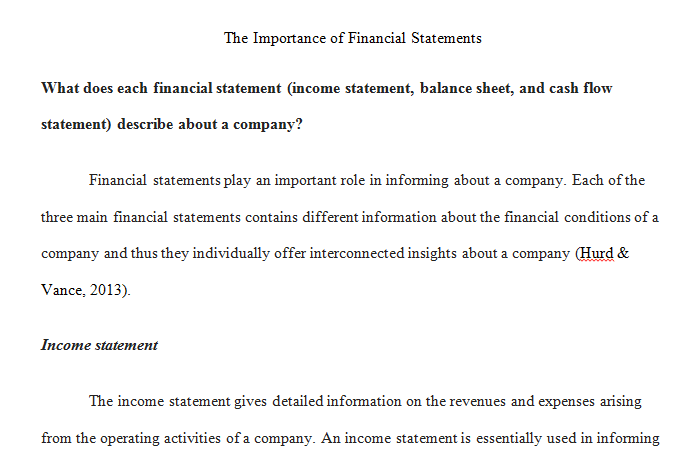The Importance of Financial Statements
These resources will help you to complete this discussion:
· Secrets of Reading Financial Reports | Transcript.
o Reading financial reports might feel like reading a letter written in code, so we have broken it down to demystify these very important documents. An illustration is provided to help you decode financial reports.
· Understand Financial Statements.
o This will help you to understand financial basics.
Imagine that you and two of your college friends, Jamie and Chen, just won a chance to go on Shark Tank, the show that invites entrepreneurs to pitch new business ideas to multimillionaires (the “Sharks”) in hopes of gaining financial backing from them.
From watching the show, you know that the “Sharks” will be asking about your financial statements, so you want to be prepared. Because you are the only one who has any business background and knowledge, you will need to educate your business partners about financial statements. You feel they should know the function of financial statements and how they tell the story about a business.
In preparation for your big meeting with the “Sharks,” you and your business partners start talking about financial statements, and you have pulled together some notes. In your post, write out what you will be covering with Jamie and Chen:
· What does each financial statement (income statement, balance sheet, and cash flow statement) describe about a company?
· What will the “Sharks” be looking for when they look at your financial statements?
· Which financial statement is the most important? Why?
· What else should your partners know about financial statements so they will know how to answer the “Sharks'” questions in a compelling way?
Topic Resources
Refer to these resources if you need clarification or additional support on the topics of this unit.
· Ross, S. A., Westerfield, R. W., Jaffe, J. F., & Jordan, B. D. (2018). Corporate finance: Core principles and applications (5th ed.). New York, NY: McGraw-Hill.
o Chapter 1, “Introduction to Corporate Finance,” pages 1–18. This chapter introduces the discipline of finance and describes the structure of the corporate firm, the importance of cash flows over profits, and the primary goal of financial management—to maximize shareholder value.
o Chapter 2, “Financial Statements and Cash Flow,” pages 19–42. This chapter covers concepts that you have already been exposed to in accounting—the financial statements, namely the big three statements: the balance sheet, income statement, and the cash flow statement. From these statements, the financial condition of the firm can be found and analyzed.
· Robinson, P. (2015, October 19). It is not all about shareholder value. Investment Advisor.
· Birkinshaw, J., Foss, N. J., & Lindenberg, S. (2014). Combining purpose with profits. MIT Sloan Management Review, 55(3), 49–56.
· Stybel, L. J., & Peabody, M. (2010). Enhance assets or reduce liabilities. MIT Sloan Management Review, 51(4), 96.
· Hurd, M., & Vance, A. (2013, April 15). How to read a financial statement. Business Week, 70–71.
Multimedia
· Financial Acumen Self-Assessment.
o This self-assessment will identify your strengths and weaknesses in financial literacy.
· Financial Terms: Interactive Glossary | Transcript.
This is a flashcard-style glossary of financial terms. Keep it handy and refer to these
Solution preview for the order on the Importance of Financial Statements
APA
885 words
